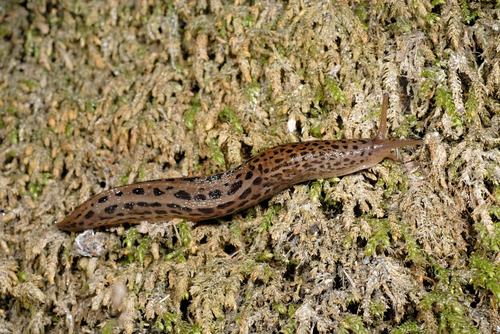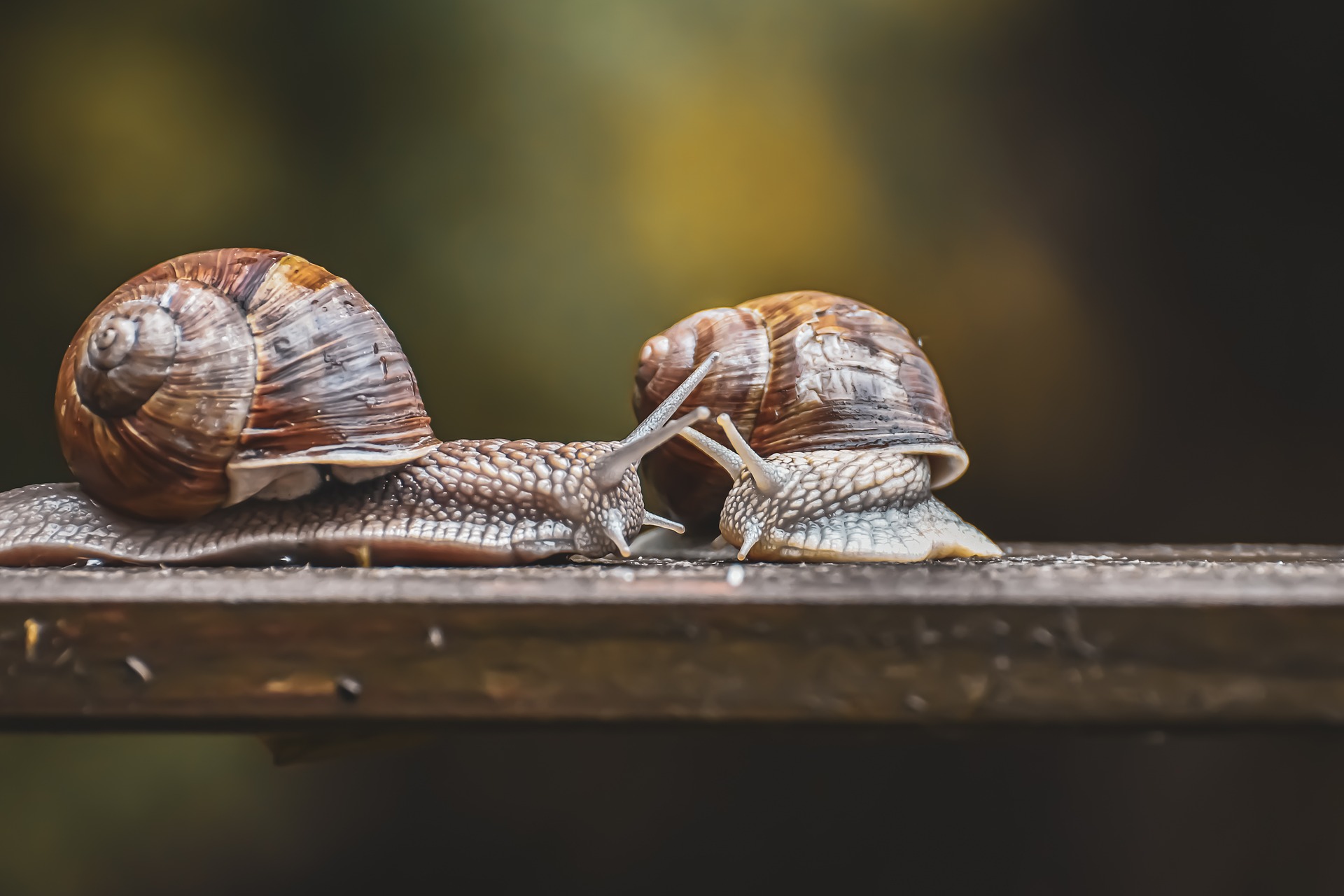Bright side of the night – 2.2.7
Snails and slugs
Snails and slugs can be found on land, in freshwater ponds and streams, and in salt water oceans. While snails have shells, slugs are naked.
Most European terrestrial snail and slug species move mainly at night or in the early morning or evening when it is still cool and damp. They are also active when it has rained. Smell, taste, moisture, temperature and touch in particular are sensory information that snails pick up from sensory cells distributed over the surface of their bodies. These cells are concentrated in the area of the head and the antennae and lips. Two environmental factors that influence snails negatively are drought and cold.
Great slug
Leopard slugs (Limax maximus) is among the largest keeled slugs. They have spread throughout Central Europe nowadays, and are found in meadows, gardens, and parks. These nocturnal animals spend the day in hiding, in compost heaps, and under piles of leaves, branches, or wood. They feed on withering or dead fungi, but also on fresh plant parts as well as corpses and rather rarely predatorily on other slugs. Because slugs eat the eggs of other slugs and their offspring, they are considered beneficial, especially in vegetable gardens. The most spectacular feature of these hermaphrodites is mating. It takes place at night. Two snails pursue each other (stimulated by scent substances in the slime) to an elevated position, such as a branch. There, they lower themselves with a self-generated thread of slime up to 40 cm and mate in an entwined and free-hanging position. Leopard slugs can grow up to 20 cm long.


Further resources
Links below will redirect you to external websites. In accordance with the European data protection declarations, we would like to point out that by clicking on these links you may send data to external providers. We cannot prevent that.
Images
![]() A vast number of photos of snails and slugs can be accessed at Pixabay.
A vast number of photos of snails and slugs can be accessed at Pixabay.
Videos
![]() BBC Who Knew Slugs Could Be So Romantic
BBC Who Knew Slugs Could Be So Romantic
Online resources
![]()
 The influence of light pollution on plants, animals and ecosystems (Helle Not)
The influence of light pollution on plants, animals and ecosystems (Helle Not)
![]()
 What happens at night just beyond our doorstep? Bothersome-Brightness-Cartoons. (Helle Not)
What happens at night just beyond our doorstep? Bothersome-Brightness-Cartoons. (Helle Not)
![]()
 Verlust der Nacht / Loss of the Night: Interdisciplinary Research network
Verlust der Nacht / Loss of the Night: Interdisciplinary Research network
![]() Into the Night in the Kaunertal Valley (Online publication)
Into the Night in the Kaunertal Valley (Online publication)
 Unterwegs in die Nacht im Kaunertal (Online publication)
Unterwegs in die Nacht im Kaunertal (Online publication)
 Konzept zur nachtbezogenen Naturpädagogik (Online publication)
Konzept zur nachtbezogenen Naturpädagogik (Online publication)
Further readings
![]()
 Regularly updated Literature and links with regards to light pollution and dark skies (Helle Not)
Regularly updated Literature and links with regards to light pollution and dark skies (Helle Not)
![]()
 Literature & Links on the website “Verlust der Nacht/Loss of the Night”
Literature & Links on the website “Verlust der Nacht/Loss of the Night”
![]() Website: General information on snails, slugs and other molluscs
Website: General information on snails, slugs and other molluscs
 Website: Information über Schnecken und andere Weichtiere
Website: Information über Schnecken und andere Weichtiere
Teaching Material
For Kids
![]()
 Materials for young scientists: Quiz, Arts and craft corner, App and Exhibition for schools. (Loss of the Night network)
Materials for young scientists: Quiz, Arts and craft corner, App and Exhibition for schools. (Loss of the Night network)
 Unterrichtsmaterialien für Schulen – “Tierprofi Wildtiere” (Die Umweltberatung)
Unterrichtsmaterialien für Schulen – “Tierprofi Wildtiere” (Die Umweltberatung)
 Unterrichtsmaterialien für Schulen – “Lichtverschmutzung” (Die Umweltberatung)
Unterrichtsmaterialien für Schulen – “Lichtverschmutzung” (Die Umweltberatung)
 Wissens- und Methodenbox „Kunstlicht, Nacht und Sternenhimmel“ (Naturfreunde)
Wissens- und Methodenbox „Kunstlicht, Nacht und Sternenhimmel“ (Naturfreunde)
